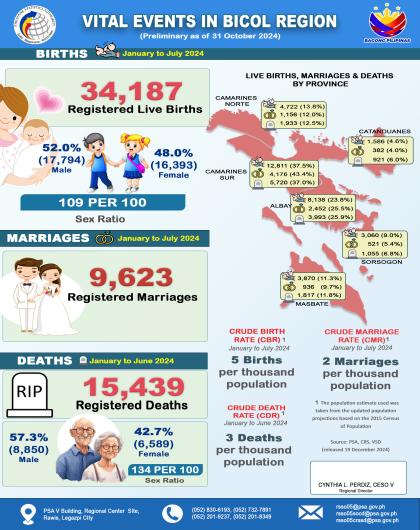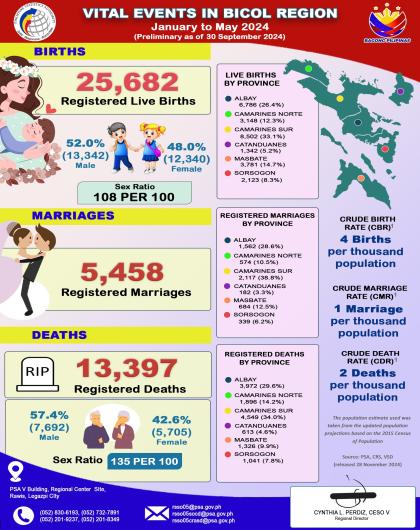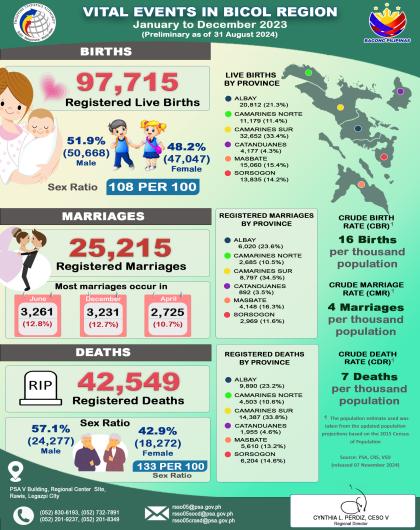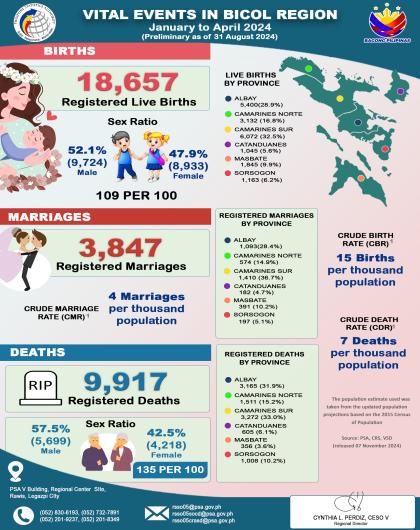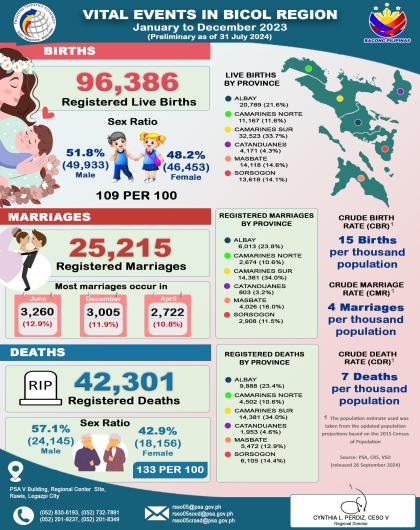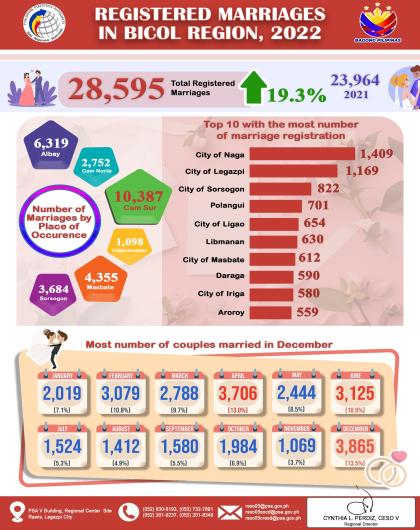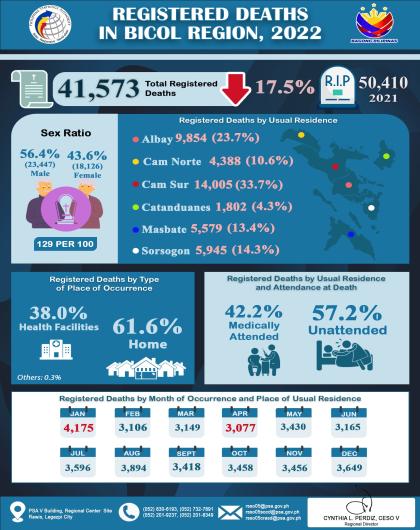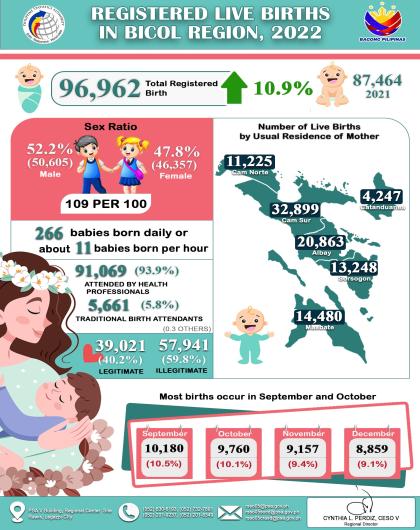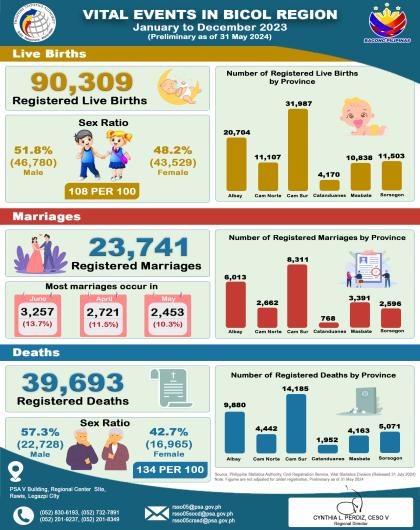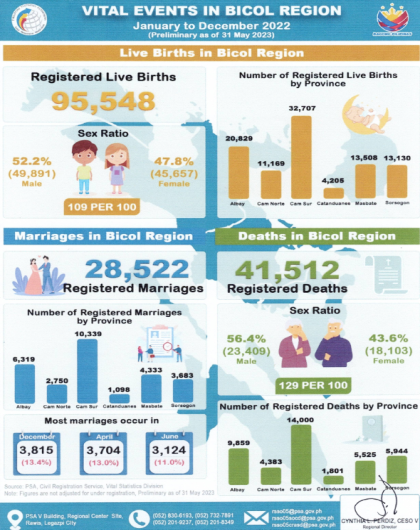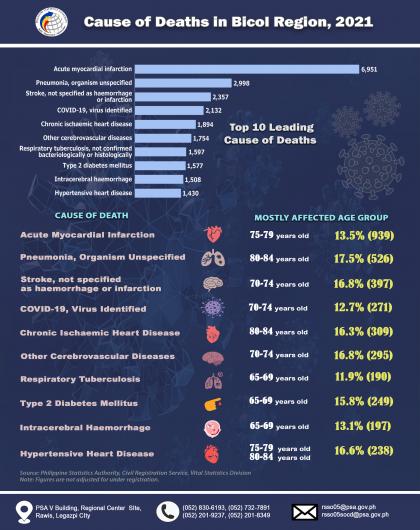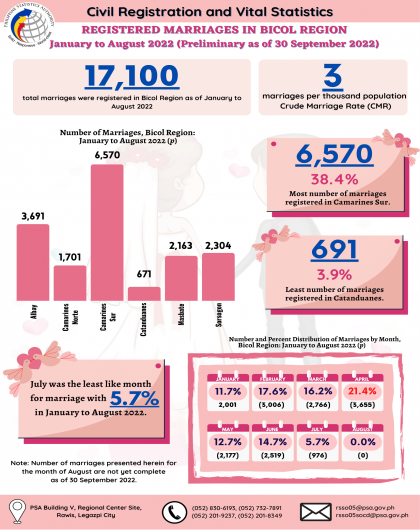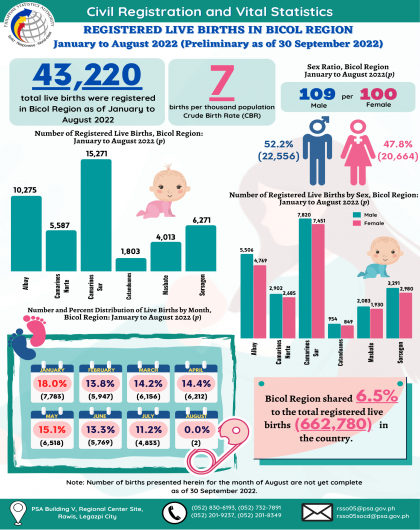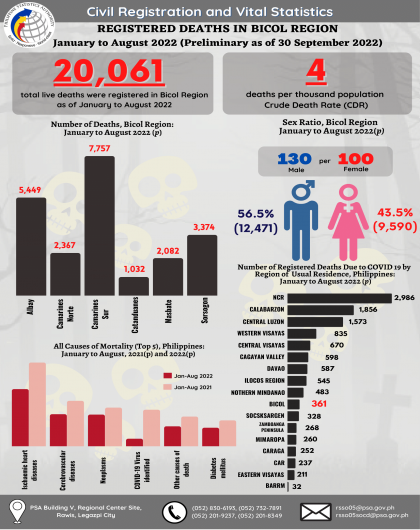

Sixteen births per thousand population
From January to December 2023, a total of 97,715 live births were registered in Bicol Region. This figure is about 6.7 percent share to the total registered live births (1,448,522) in the country. For this period, Bicol Region registered a crude birth rate1 (CBR) of 15.5 or 16 births per thousand population.
The number of registered live births slightly decreased to 0.8% or a difference of 753 live births from 96,962 registered births during the same period in 2022. Figure 1 shows the number of registered live births in the Bicol Region from January to December 2023. Camarines Sur had the highest number of births, with 32,652 (33.4%) registered. It was followed by Albay with 20,812 (21.3%), Masbate with 15,060 (15.4%), Sorsogon with 13,835 (14.2%), and Camarines Norte with 11,179 (11.4%). Catanduanes recorded the least number of births, with 4,177, accounting for about 4.3% of the total registered births in the region.

More males born than females
From January to December 2023, all provinces in the Bicol Region recorded more male births (50,668 or 51.9%) than female births (47,047 or 48.1%), resulting in a sex ratio of 108 males per 100 females.
On average, about 268 babies were born daily, or approximately 11 babies per hour in the region.

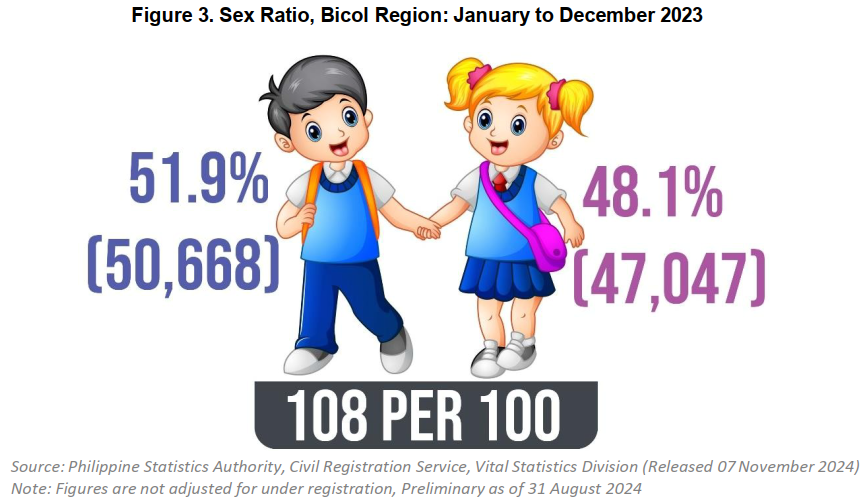
Most births occur in September
The most number of births in the Bicol Region from January to December 2023, occurred in September, with 9,673 births (9.9%). This was followed by January with 9,278 births (9.5%), October with 9,180 births (9.4%), and December with 8,776 births (8.7%). April recorded the fewest births with 7,037 (7.2%).


Registered marriages decreased to 10.8 percent
From January to December 2023, a total of 25,511 marriages were registered in Bicol Region. This figure decreased to 10.8 percent or a difference of 3,084 marriages compared with 28,595 marriages in 2022. The total registered marriages in January to December 2023 is equivalent to a crude marriage rate1 (CMR) of 4.0 or 4 marriages per thousand population.
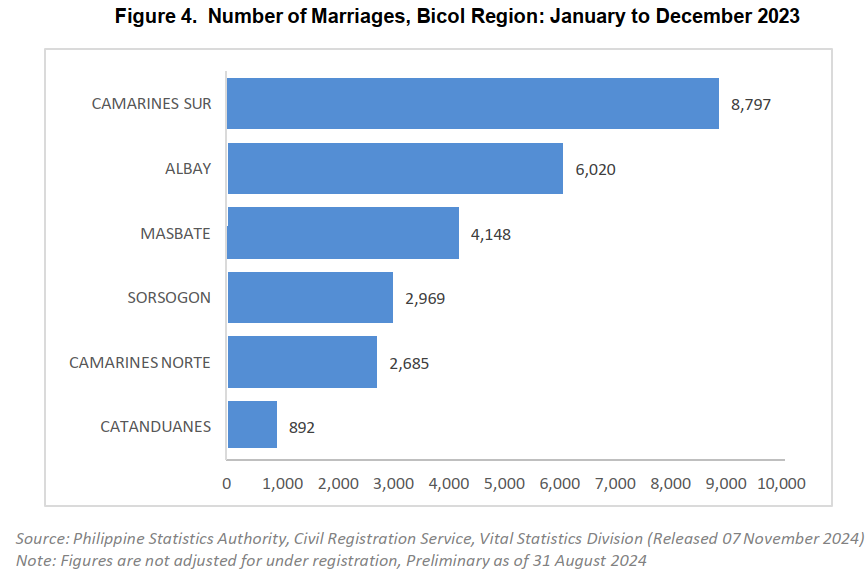
Among provinces, Camarines Sur had the most number of marriage registration from January to December 2023 with 8,797 (34.5%) registered marriages. This was followed by Albay with 6,020 (23.6%) registered marriages, the province of Masbate with 4,148 (16.3%) registered marriages, the province of Sorsogon with 2,969 (11.6%), and the province of Camarines Norte with 2,685 (10.5%). Catanduanes had the least number of registered marriages with 892, accounting for 3.5 percent of the total in the region.
Most number of couples married in June
From January to December 2023, the month of June recorded the most number of registered marriages with 3,261 or 12.8 percent share to the total marriages in Bicol Region. December ranked second with 3,231 (12.7%), followed by April with 2,725 (10.7%). November had the least number of registered marriages with 834 (3.3%).
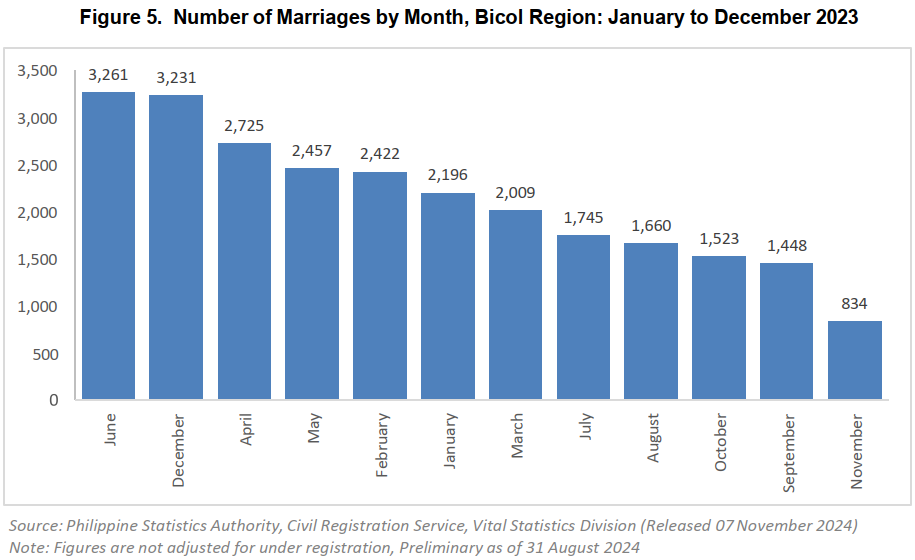

Around seven deaths per thousand population
Reported deaths from January to December 2023 reached 42,549, an increase of 2.3% from 41,573 registered deaths during the same period in 2022. This is equivalent to a Crude Death Rate1 (CDR) of 6.8 or about 7 deaths per thousand population. From January to December 2023, there was an average of 117 deaths per day, or 5 deaths per hour, in the Bicol Region.
Most number of deaths reported in Camarines Sur
The most number of registered deaths occurred in Camarines Sur with 14,387 (33.8%), followed by Albay with 9,890 (23.2%), Sorsogon with 6,204 (14.6%), Masbate with 5,610 (13.2%), Camarines Norte with 4,503 (10.6%), and Catanduanes with 1,955 (4.6%). The combined registered deaths from these six provinces accounted for 6.1 percent of the total registered deaths in the country, which was 694,821.
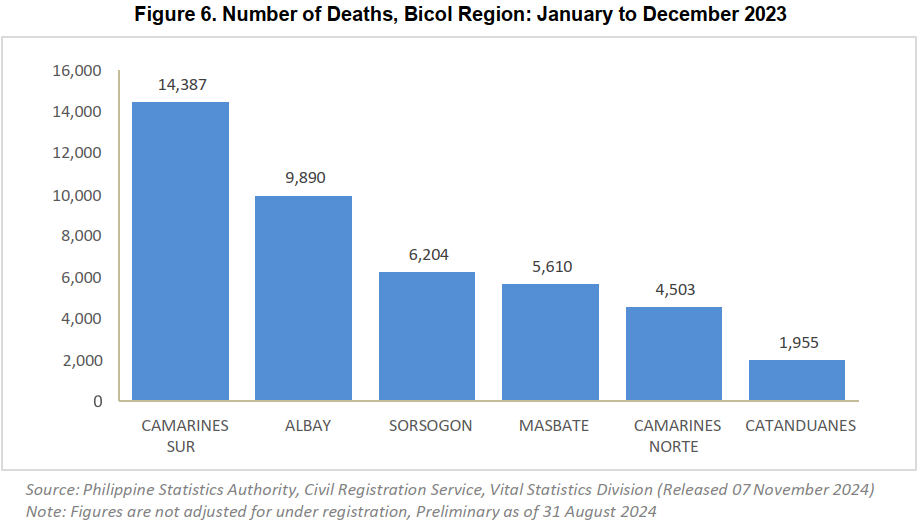
More male deaths than female in January to December 2023
The most number of deaths in Bicol Region occurred among males with 24,277 or 57.1% registered deaths. Females accounted for 42.9% or 18,272 deaths, resulting in a sex ratio of 133 males per 100 females, indicating a higher survival rate of females than males.

DEFINITION OF TERMS AND CONCEPTS
Live Birth is a complete expulsion or extraction from its mother of a product of conception, irrespective of the duration of the pregnancy, which after such separation, breathes or shows any other evidence of life, such as beating of the
heart, pulsation of the umbilical cord, or definite movement of voluntary muscles, whether or not the umbilical cord has been cut or the placenta is attached; each product of such a birth is considered liveborn.
Crude Birth Rate (CBR) refers to the number of live births per 1,000 mid-year population.
Sex Ratio – the number to the males per 100 females in a population.
Marriage is a special contract of permanent union between a man and a woman entered into in accordance with law for the establishment of conjugal and family life.
Crude Marriage Rate (CMR) is a gross measure of the level of the relative frequency of marriages in an area for a given year. It expresses additions, by the formal means of legal marriage, being made to the married segment of the
total population. This refers to the number of marriages per 1,000 mid-year population.
Death refers to the permanent disappearance of all evidence of life at any time after live birth has taken place (postnatal cessation of vital function without capability of resuscitation).
Crude Death Rate (CDR) refers to the number of deaths per 1,000 mid-year population.

